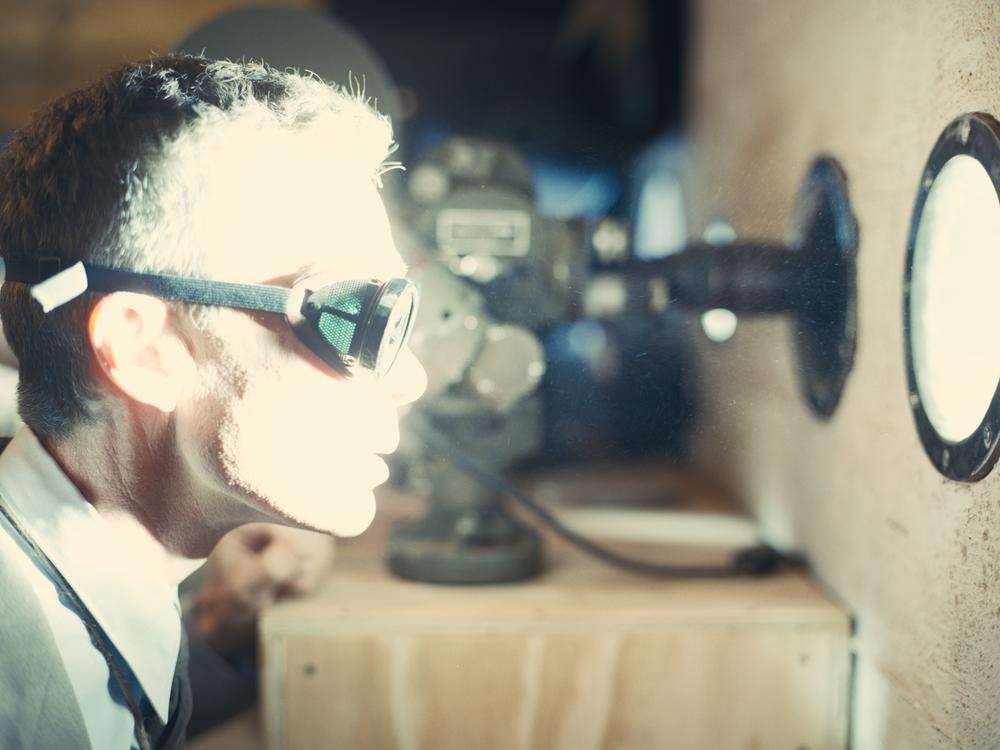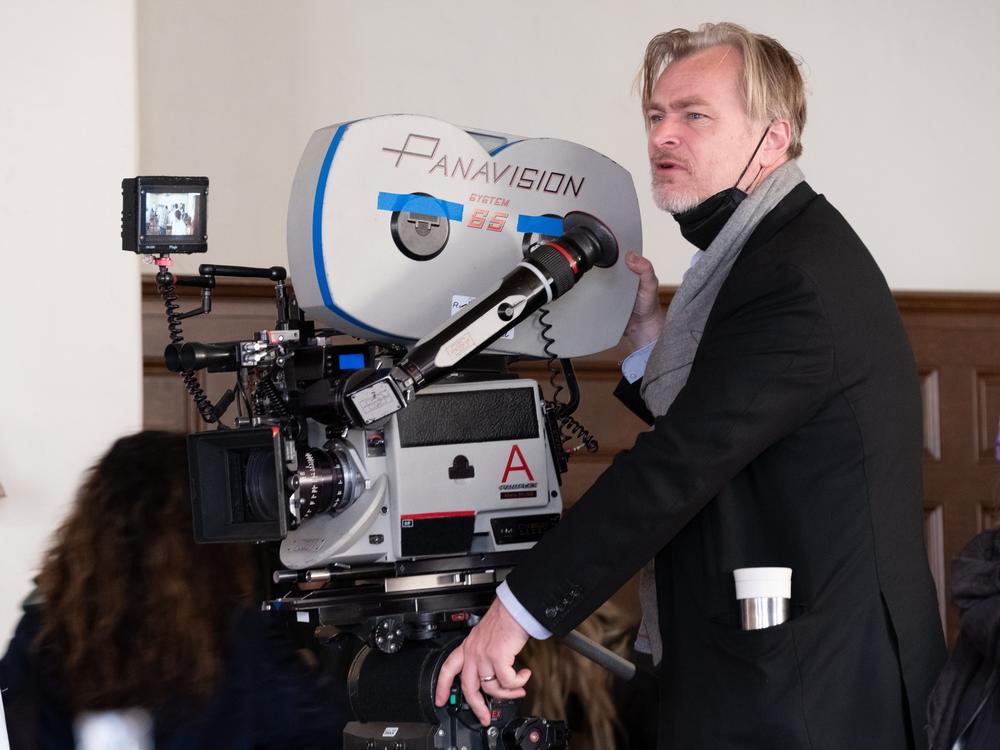Section Branding
Header Content
'Like it or not, we live in Oppenheimer's world,' says director Christopher Nolan
Primary Content
Oppenheimer writer and director Christopher Nolan is no stranger to dark, brooding films. His list of credits includes the Batman trilogy, Dunkirk, Inception and Insomnia. But he says the story of Robert Oppenheimer, known as the father of the atomic bomb, stayed with him in a way his other films didn't.
"If movies are a sort of collective dream, there's a sense in which Oppenheimer's a collective nightmare," Nolan says. "Of all of the subject matter I've dealt with, it's certainly the darkest."
A theoretical physicist, Oppenheimer directed Los Alamos, the secret project in New Mexico where researchers developed the first nuclear bombs, and conducted the Trinity test, a trial detonation, on July 16, 1945. A month after that test, the U.S. dropped atomic bombs on the Japanese cities of Hiroshima and Nagasaki, killing as many as 200,000 people in an effort to end World War II.
Nolan says he was drawn to the tension of Oppenheimer's story — particularly the disconnect between the joy the physicist felt at the success of the Trinity test, and the horror that later resulted.
"At the heart of the film, there's a pivot, and it's really the pivot between the successful Trinity test and then the bombings of Hiroshima and Nagasaki — the actual use of the weapon," Nolan says. "Whether we like it or not, we live in Oppenheimer's world, and we always will."
After the war, Oppenheimer became an advocate of arms control, and opposed military plans for massive strategic bombing with nuclear weapons, which he considered genocidal. In 1954, during the height of the anti-Communist era, he was accused of being a risk to national security. The Atomic Energy Commission stripped Oppenheimer of his security clearance in June 1954, irrevocably damaging his career. (In December 2022, Energy Secretary Jennifer Granholm reversed the AEC's decision.)
Nolan says Oppenheimer's story resonates today, especially as we talk about the dangers of artificial intelligence.
"A lot of the researchers in AI talk about this as their Oppenheimer moment," Nolan says. "They're looking at his story and sort of saying, 'OK, what are the responsibilities of a researcher or a scientist bringing something into the world that may have unintended consequences?' "
Interview highlights
On how science advances before we know the consequences
They knew the theory [of nuclear fallout] and they knew the possibilities to some degree. But as with so much in science, the real knowledge comes from experimentation. This is the nature of science, is it moves forward, continually correcting itself. Science is not a process whereby you are able to sit down and perfectly map everything out in theoretical terms, and then that just becomes the future. It has to interact with the real world — and to a certain extent our film is about the consequences of that.
On creating the image of the explosion without CGI
One of the first people I showed the script to when I finished it was my visual effects supervisor, Andrew Jackson, and I showed it to him right away because I said to him, "We have to get the Trinity test across. We also have to try and give some insights into the way Oppenheimer would have visualized molecular interactions and how that builds to its ultimate expression in the Trinity test. But I want to do it without computer graphics." And the thing with CG, even though it's very versatile, as animation, it tends to feel a bit safe, a bit anodyne. And it was very important to me that firstly, the atomic interactions that Oppenheimer's visualizing, but then, ultimately, the power of the device they build itself — the "gadget," as they called it — that they detonated at Trinity, you wanted it to be the most beautiful and most terrifying thing simultaneously.
So Andrew spent many months experimenting with very small things, very microscopic images that could be filmed to represent bigger things, but then also massive explosions using different forms of explosives, magnesium flares, petrol explosions, black powder explosions, things like that, different frame rates and so forth. So there was just a lot of experimentation that went into it. And what I was very happy about was that the imagery that he was giving me did have the requisite threat, even with its hypnotic beauty.
On capturing the tension of the Trinity test
We had engineered a situation whereby we were performing very large explosions for the actors there, out in the desert in the middle of the night, in the same bunkers they would have been in. But I think that gave all of us some feeling of the tension that would have been there leading up to the Trinity test in particular, because when you do pyrotechnic effects, safety is obviously of paramount importance. And so there's an extraordinary amount of tension and planning around those moments before you trigger those events. And there's always that slight uncertainty about exactly what they're going to look like, what they're going to sound like, how frightening they're going to be, essentially. So I think all of us, in our own small way, got some taste of what the tension there would have been for the people at Trinity. And I think that that helped us construct the drama of it for the audience.
On his approach to the biopic
In a funny sort of way, my approach is to not even acknowledge biopic as a genre. In other words, if something works, like Lawrence of Arabia, for example, you don't think of it as a biopic. You think of it as a great adventure story, even though obviously it's telling the story of somebody's life. Or Citizen Kane ... I mean, obviously that's fiction. But for me, I had the benefit of this extraordinary book [written by Martin Sherwin and Kai Bird], American Prometheus, that ... won the Pulitzer Prize. I had this extraordinary sort of bible to work from. And so for me, it was really a process of saying, "OK, what's the exciting story that develops, the cinematic story that develops from a reading of it, from several readings of it?" And then [I] started to develop a structure for how I might be able to put the audience into Oppenheimer's head.
On why he shot his film in IMAX
I've used IMAX for years and going into Oppenheimer, talking to [Hoyte van] Hoytema, my [director of photography], we knew that it would give us with its high resolution, its sort of extraordinary analog color sharpness ... the big screens that you projected on, we knew it would give us the landscapes of New Mexico, that it would give us the Trinity test, which we felt had to be a showstopper.
But we actually got really excited about the idea of the human face. How can you help us jump into Oppenheimer's head? The story is told subjectively. I even wrote the script in the first person — "I" this, "I" that. We were looking for the visual equivalent of that. And so taking those high-resolution IMAX cameras and really just trying to be there for the intimate moments of the story in a way that we felt we hadn't really seen people do before with that format. That was a source of particular excitement for us.
Lauren Krenzel and Thea Chaloner produced and edited this interview for broadcast. Bridget Bentz, Molly Seavy-Nesper and Beth Novey adapted it for the web.
Copyright 2023 Fresh Air. To see more, visit Fresh Air.


